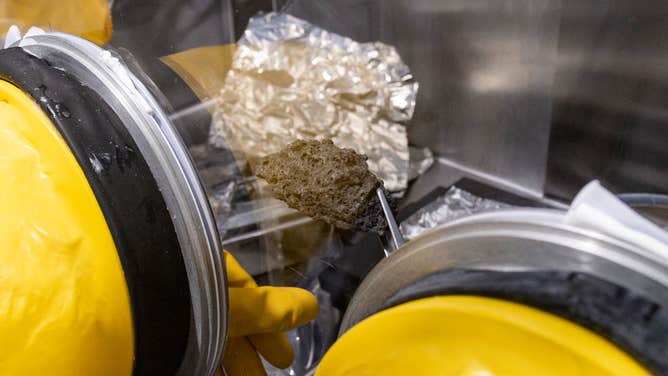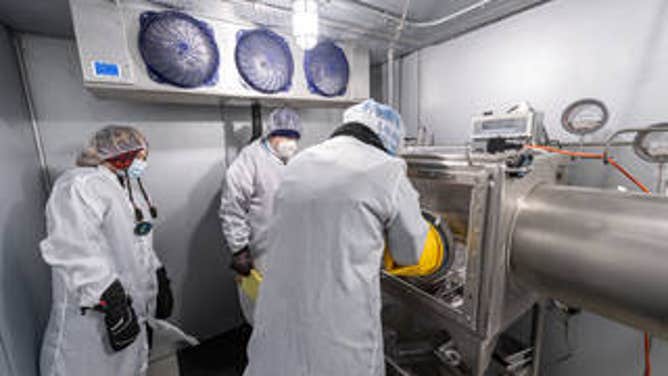50-year-old frozen moon samples to help NASA's future missions
Scientists at NASA's Goddard Space Flight Center in Greenbelt, Maryland, recently received samples of the lunar surface curated in a freezer for half a century
GREENBELT, Md. – Pieces of the moon that have been locked in a freezer for nearly 50 years may now help NASA with future missions.
Scientists at NASA's Goddard Space Flight Center in Greenbelt, Maryland, recently received samples of the lunar surface curated in a freezer for half a century.
The samples were kept at NASA's Johnson Space Center in Houston since Apollo 17 astronauts brought them to Earth in December 1972.
NASA says that they will use the samples from the Apollo program in advance of the upcoming Artemis missions to the moon's south pole.

A frozen Apollo 17 sample being processed inside a nitrogen-purged glove box at NASA’s Johnson Space Center in Houston. The sample is one of many being studied as part of the ANGSA program.
(NASA/Robert Markowitz)
They hope the Apollo Next Generation Sample Analysis Program, or ANGSA, will maximize the science derived from samples returned by the Apollo Program in preparation for future lunar missions.
Scientists say that transporting the Apollo 17 samples to Goddard Space Center wasn't easy.
"We started this in early 2018, and there's been a lot of technical challenges that we've had to overcome to get to this point," said NASA's Julie Mitchell. "This was seen as a practice run for preparing a facility for future cold sample processing."
Mitchell and her Artemis curation team began designing a facility to handle the frozen samples.
NASA DEVELOPS "MOON DUSTER" TO ZAP AWAY LUNAR DUST
"By doing this work, we're not just facilitating Artemis exploration, but we're facilitating future sample return and human exploration into the rest of the solar system," Mitchell added. "I feel very privileged to contribute in this small way by developing the capabilities for us to collect these materials, bring them home safely, and curate them for the long term."
When the facility was ready, NASA says that Ryan Zeigler, Apollo sample curator in the Astromaterials Research and Exploration Science (ARES) Division at Johnson, and his team had to adapt to the unique conditions to keep the samples frozen during processing. Keeping the pieces frozen is important for Artemis as astronauts potentially return ice samples from the moon's south pole.
Ziegler says working against frost in a walk-in freezer kept at minus 4 degrees Fahrenheit was the real challenge.

Three ARES scientists process frozen Apollo 17 samples inside a walk-in freezer maintained at minus 4 degrees Fahrenheit (minus 20 C). Beneath the laboratory gown, they don parkas, gloves, and hats to keep warm.
(NASA/Robert Markowitz)
"Everything we do involves a lot of logistics and a lot of infrastructure, but adding the cold makes it a lot harder," said Zeigler. "It's an important learning lesson for Artemis, as being able to process samples in the cold will be even more important for the Artemis mission than it is for Apollo. This work gives us some lessons learned and a good feed forward for Artemis."
Once processed, the samples were sent in dry ice to Goddard and immediately stored in a secure freezer.
Researchers at Goddard Space Center focus on small organic compounds that previous research showed that some lunar samples contain amino acids, which are essential to life on Earth.
NASA'S ARTEMIS MOON ROCKET BACK IN THE HANGAR FOR REPAIRS
"We think some of the amino acids in the lunar soils may have formed from precursor molecules, which are smaller, more volatile compounds such as formaldehyde or hydrogen cyanide," said research scientist Jamie Elsila. "Our research goal is to identify and quantify these small organic volatile compounds, as well as any amino acids, and to use the data to understand the prebiotic organic chemistry of the Moon."
Other factors that are crucial to the research are the lifespan of the samples on the moon. Knowing the rocks' history can help identify exposures of space.
"Our work allows us to use noble gases, such as argon, helium, neon, and xenon, to measure the duration a sample has been exposed to cosmic rays, and this can help us understand the history of that sample," said investigator Natalie Curran. "Cosmic rays can be damaging to organic material that may be in a sample, so understanding the duration helps to determine the effects that exposure has had on the organic."
Scientists will analyze both samples set at room temperature and frozen to identify any differences in organic content. NASA says that understanding any variations caused by the different curation methods might inform future decisions about how to store samples returned by Artemis astronauts.